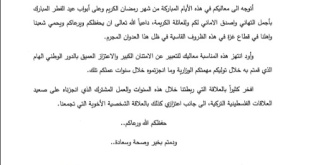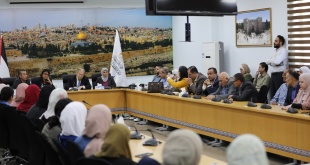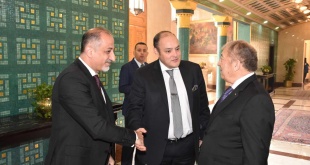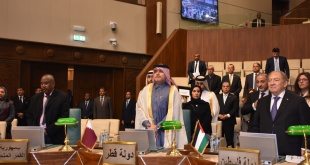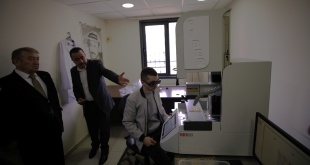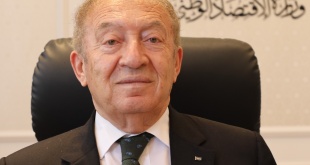All we had to do was to maneuver between manned checkpoints, metal gates that prevented passage between neighborhoods, and large mounds of dirt put in place by the army between streets. The logical route to take, which leads straight from the Tomb of the Patriarchs to the city center, was closed some time ago, when Shuhada Street became King David Street and the settlers took over this “compound.” The 1997 Hebron agreement, which divided the city into two areas, the Arab H1 and the Jewish H2, also thrust a barrier into the heart of the city and physically divided the Jewish part from the Arab part.
According to the agreement, Israel Defense Forces soldiers are forbidden to cross into area H1 without a Palestinian escort. During the day, foot patrols of soldiers go about the area as if it were theirs. At night, the army arrives to carry out arrests, and just instructs the Palestinian security forces to remain in their eadquarters and not to intervene, as if they were its servants
A star at City Hall
“.On the desk in the spacious office of Khaled Osaily, the mayor of Hebron, who was appointed to the post exactly a year ago, is a colorful map of the city, on which are marked all of the 112 barriers erected in it. “And these are just the checkpoints inside Hebron,” Osaily stresses. “In the entire district, we have 268 checkpoints.” Has any checkpoint been removed since Israel pledged to ease the living conditions in the West Bank? Osaily laughs. “Nothing has been removed. I think some checkpoints were even added .
Osaily isn‘t serving in his post simply so that he can lament the bitter fate of the Palestinians under the occupation, but rather to do the best he possibly can under difficult conditions. A sort of positive resistance. He inherited this quality from his father, Zuhair Osaily, who was one of the biggest merchants in both the territories and Israel, a consummate businessman whose kindheartedness and willingness to help others rivaled his business acumen. Osaily, Sr. understood that one can‘t base one‘s life on mere hatred of reality, and he passed this insight on to his children.
I met Zuhair and his son Khaled when I was serving in my official role as an occupier of Hebron in the 1970s, when the military administration still laid claim to the title of “enlightened occupier.” Enlightenment was measured at the time in administration reports, in which the various staff officers proudly noted how many refrigerators and TV sets had been purchased by the Palestinians. Zuhair warned us then not to fall into the trap of thinking that living the good life would be enough for the Palestinians. “A good economy is a necessary thing,” he said. “But it‘s no substitute for a Palestinian state.” We heard but we didn‘t listen.
In the 1976 municipal elections, Zuhair agreed that Khaled, then 28, would run in a united bloc headed by Fahd Kawasme, and challenge the all-powerful leader Sheikh Mohammed Ali al-Ja‘abari. It was a very gutsy step and quite extraordinary in the context of clan-driven Hebron. Kawasme‘s victory ushered in the youngest city council member the West Bank had ever known: Khaled Osaily. When then-defense minister Shimon Peres came to Hebron City Hall for a post-election visit, he was welcomed by Khaled, who was dressed in jeans, a fitting sign of the profound change in the leadership: from an abaya (caftan) and kaffiyeh to jeans and a short-sleeve shirt, from “sheikhs” and “hajjis,” who kiss the mayor‘s hand when they enter his office with a request, to business people and university graduates. And then it was they, of all people, whom the military administration decided to boycott, and to support the establishment of the village associations instead.
A year ago, at the request of Palestinian Authority President Mahmoud Abbas, Khaled Osaily “lent” himself to the Hebron municipality, leaving his son, Zuhair, who lives in Ramallah, plus a team of talented managers, to oversee his worldwide business interests. He brought his management methods to the Hebron city government, and, in just one year, was able to advance certain matters that had been stuck for decades. From a drawer in the office cabinet he pulls out a report on annual activity and 12 more monthly reports. “Each month we write a report on the municipality‘s activity, including expenses and income, and visits and initiatives. It‘s part of our commitment to transparency. Everything is out in the open. Everything is published,” he explains. For someone who remembers when Hebron was run according to the personal management style of Sheikh Ja‘abari, this is more than a revolution: It‘s practically science fiction.
For example, there‘s Bahira Rasras, a Hebron resident and daughter to a family of refugees who fled in 1948, an engineer who is now in charge of running the municipality‘s GIS. And what is this GIS Osaily established? It stands for “Geographical Information System.” Rasras gets the computer on her desk to quickly bring up a map of the city of Hebron. Next to the map is a chart on which data can be inserted concerning specific plots, along with the owners‘ names or ID numbers. If just one piece of data is entered, a picture of the property comes up on the screen, along with the history of the property‘s ownership and information about any debts, permits that were granted to the owners and all other pertinent information.
More than 55,000 housing units have been fed into the database to date, making it possible to keep track of taxes and construction. All of a sudden, every building has an address, with a street and a number. And this is in Hebron, where it was normal for an individual to say that he lives, say, in the Abu Sneineh quarter near so-and-so‘s garage, or just Harat al-Sheikh – and that‘s enough.
Press another button on the keyboard and another map appears on the screen, on which are marked the city‘s mosques, clinics, schools, hospitals and hotels. And yes, for the first time in Hebron‘s history, there is also a tourist map, noting all the important sites. There may be no actual tourism in the city – after all, who can enter Hebron from its Arab side – but the vision of it already has a map.
Now I‘m planning to make the municipality electronic,” continues the mayor. My startled look isn‘t sufficiently disguised, apparently. I‘m still stuck on the memory of the “municipality of little pieces of paper and winks” that was the norm in previous generations” .
“The city government will have a Web site, which everyone will be able to access from home, so they can carry out all the necessary activities – pay taxes, request permits, get information or just read about the different development programs,” says Osaily, explaining the principle. But does everyone have a computer? “Anyone who doesn‘t have a computer will have to come to City Hall himself, and another surprise will await him here. Instead of running from one clerk to another, he‘ll deal with a single teller on the ground floor, so the elderly and the disabled can also receive service, and within minutes, after hardly waiting in line at all, he‘ll be able to finish taking care of his business”.
The system is already up and running, and the result is impressive. According to Osaily, there has been a significant increase in the rate of municipal tax and water bills being paid: up from 46 percent to 73 percent. Electricity payments are still lagging, but a new device, a smart card to be installed in electric meters, should soon solve that problem, too.
Osaily is not about to be satisfied with the amount of these payments, either. Although he has a $100-million budget to devote to the welfare of 250,000 city residents, who live in a 47-square-kilometer area, that isn‘t enough to be able to build a 4,500-seat stadium, to surface the soccer field with artificial turf, to operate enrichment centers for children and also to pay the salaries of approximately 1,300 municipal employees. Not even an additional $30 million will suffice. Certainly not when Osaily has also decided to launch another business initiative in the city.
Revived life
In the area that borders the “Jewish yishuv (community)” – next to Beit Hadassah and the Avraham Avinu neighborhood, and the old vegetable market and the casbah – hundreds of Arab shops and homes have been shut down (1,819 shops and approximately 1,000 apartments, by the municipality‘s count). Some shops were closed under orders from the army and some closed down in the wake of harassment by settlers, which caused shoppers to stay away. Osaily decided to revive the commercial life of these areas and is paying every storeowner who reopens his business $200 a month for six months. Customers have yet to return in droves, but the initiative is already beginning to have a positive effect.
This is his method: Instead of just complaining, he alters reality to his benefit. Thus, Osaily is busy marketing the city to anyone who can possibly help – from Quartet representative Tony Blair and the U.S. ambassador, to representatives of the oil-producing countries. Each one gets a tour around town and is asked to look into the possibility of contributions. To date, the mayor has made a total of about $300 million in formal aid requests for development programs. The money hasn‘t arrived yet, but Osaily is confident that he will receive most of it. The problem comes afterward, with the permits the Israeli civil administration will be required to issue. For example, when the municipality wants to build a soccer field the administration feels is too close to a road that settlers travel on, the field is not approved.
When Khaled Osaily was appointed to his post, Hamas people in the city came to him and demanded that he grant them half the seats on the city council. “They told me that they knew I‘d be a success as mayor and that they wanted to be a part of it,” he explains. Osaily did not comply with the demand. “If I‘d included them, I would not have been able to receive all of the aid for the city and no donations would have been forthcoming. It wasn‘t a political question, but rather a decision about where the interests of the city‘s inhabitants lie,” he says.
“Still, the mayor knows that without Hamas‘ political involvement, it won‘t be possible to reach a peace agreement with Israel: “In another six months, or another year, there has to be reconciliation among the factions. Otherwise, we won‘t get anywhere.
Meanwhile, with the donations, he can sustain the Hebron Center for Child Enrichment, which was set up with a donation from the crown prince of Dubai. Children up to age 18 can enjoy the services at the facility, which include a library, after-school courses, and even a juggling program led by volunteers from the Ramallah Circus. In the spacious computer room, mothers learn how to be computer literate, “so they can help their children at home,” explains Shadia Sharif, the center‘s spokesperson. When we visited, about a dozen young women wearing headscarves were busy learning how to use the Photoshop program.
It‘s crowded in Hebron on Saturday. The main streets are packed with the traffic of buyers and sellers, trucks and yellow taxis throng the roads, Israeli Arabs come here to buy cheaply and resell in Israel, Palestinian policemen try to deal with the traffic jams, and peddlers wind their carts through the crowds that flow along the sidewalks and streets.
It‘s all utterly normal – until you reach the edges, where the city is hemmed in on all sides. The checkpoints and mounds of dirt, the gates and concrete blocks that make life hell. In those areas where the Arab city touches on the settler strongholds, Hebron seems like a border region. Multistory buildings are locked up, the windows covered with steel mesh, and screens jut out from the buildings, parallel to the street, to prevent the settlers from throwing their garbage on passersby. There are residents who can only reach their homes with a permit, or via the roofs. Most of all, a desolateness and pernicious quiet prevail. Here it is absolutely clear that the city is trapped within a cage, and it doesn‘t matter how many computers are in that cage, or if players on the soccer field wear uniforms made of gold
 Khaled Osaily. خالد العسيلي رئيس بلدية الخيل السابق خالد العسيلي
Khaled Osaily. خالد العسيلي رئيس بلدية الخيل السابق خالد العسيلي
